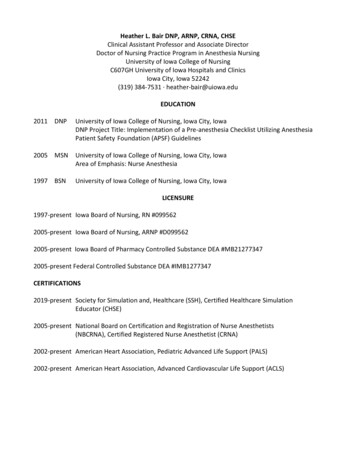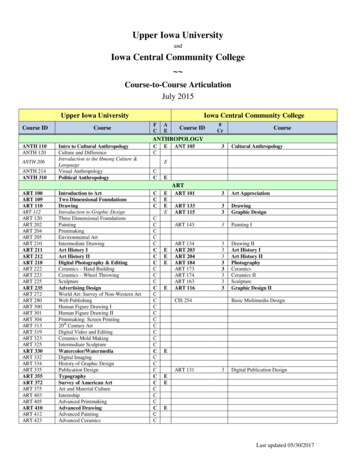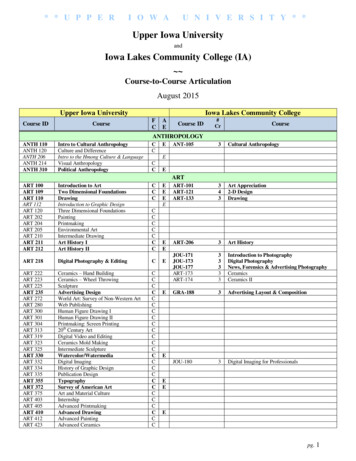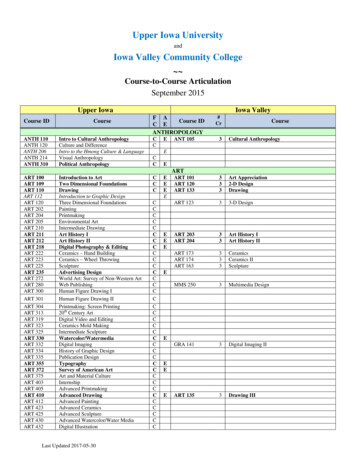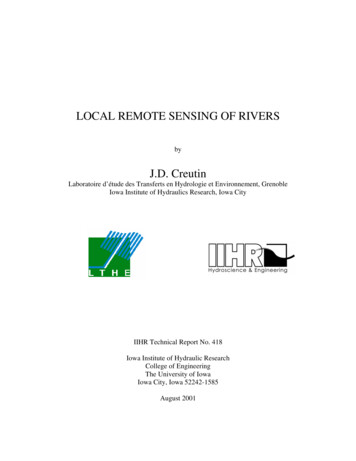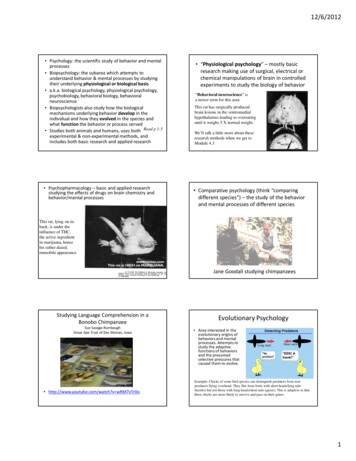
Transcription
12/6/2012 Psychology: the scientific study of behavior and mentalprocesses Biopsychology: the subarea which attempts tounderstand behavior & mental processes by studyingtheir underlying physiological or biological basis a.k.a. biological psychology, physiological psychology,psychobiology, behavioral biology, behavioralneuroscience Biopsychologists also study how the biologicalmechanisms underlying behavior develop in theindividual and how they evolved in the species andwhat function the behavior or process served Studies both animals and humans, uses both Read p 1-5experimental & non-experimental methods, andincludes both basic research and applied research Psychopharmacology – basic and applied researchstudying the effects of drugs on brain chemistry andbehavior/mental processes “Physiological psychology” – mostly basicresearch making use of surgical, electrical orchemical manipulations of brain in controlledexperiments to study the biology of behavior“Behavioral neuroscience” isa newer term for this areaThis rat has surgically producedbrain lesions in the ventromedialhypothalamus leading to overeatinguntil it weighs 5 X normal weight.We’ll talk a little more about theseresearch methods when we get toModule 4.3 Comparative psychology (think “comparingdifferent species”) – the study of the behaviorand mental processes of different speciesThis rat, lying on itsback, is under theinfluence of THC,the active ingredientin marijuana, hencehis rather dazed,immobile appearanceJane Goodall studying chimpanzeesStudying Language Comprehension in aBonobo ChimpanzeeSue Savage-RumbaughGreat Ape Trust of Des Moines, Iowa http://www.youtube.com/watch?v wRM7vTrIIisEvolutionary Psychology Area interested in theevolutionary origins ofbehaviors and mentalprocesses. Attempts tostudy the adaptivefunctions of behaviorsand the presumedselective pressures thatcaused them to evolve.Long neckShort neckExample: Chicks of some bird species can distinguish predators from nonpredators flying overhead. They flee from birds with short heads/long tails(hawks) but not those with long heads/short tails (geese). This is adaptive in thatthese chicks are more likely to survive and pass on their genes.1
12/6/2012Behavior Genetics Area of study which seeks tounderstand both the geneticand environmentalcontributions to individualvariations in behavior. This young man is grimacingbecause his genetic makeupallows him to taste the bitterchemical on the paper stripon his tongue. Others may beunable to taste this chemicalor will experience a muchmilder bitter taste. Psychophysiology- uses non-invasiverecording techniques (HR, BP, EEG, etc.) tostudy bodily changes during behavior orpsychological processesThis student has an array of EEGelectrodes applied to his scalp tomonitor brain electrical activity Cognitive neuroscience– hot new areaexamining the neuralbasis of mentalprocesses, usually usingnew brain imagingtechniques like PET scansor fMRI scans. Neuropsychology – studies the effects of braindamage in humans & how to assess those effectsThis student iscompleting theblock design test tomeasure visualspatial ability. Shemust rearrange herblocks to match thedesign the tester hasplaced before her.Psychophysiological MeasuresRead about these in Mod. 4– eye EEG – electroencephalogram EOG-electrooculogrammovements ERP – event related potentials SCR or GSR- skin conductance EMG- electromyogram of ECG/EKG-electrocardiogram & BPmuscle tensionand HR measuresConverging sources of evidence improve our understanding. Here the red and yellowspots of fMRI scans revealwhat areas of brain are activeduring bilingual or singlelanguage naming of objects. Please read 5.1 to learn aboutbrain imaging techniquesMay also need evidence from related disciplines outside of psych 2
12/6/2012Other Disciplines Studying the NervousSystem Related Medical Specialties Neurologist – diagnoses and treats those withbrain damage or nervous system disorders Neurosurgeon – performs brain surgeries Physical therapist– provides treatments toimprove movement and decrease pain Occupational therapist – works with individualsto improve or retrain the activities of y One way to study brain behavior relationships isto study the effects of brain DAMAGEBrain Atlas Detailed map of brainwith coordinates Our library has brainatlas guides for rats,monkeys, “domesticanimals” andhumans.Lesion area of damageAblation removal of a regionTemporary “lesion” by inactivatinga brain area – with a drug ortranscranial magnetic stimulation,for exampleSee p. 130Human Stereotaxic SurgeryDevice which holds the head(or attaches to the head in largerspecies) in a standard position,to allow the insertion ofelectrodes or surgical tools toprecise locations within thebrain, using calibrations on thestereotax in conjunction withthe coordinates provided bybrain atlases. In human brainsurgeries the location of theelectrode is also verified withbrain scans and behavioraltesting.3
12/6/2012 An alternative to studying the effects ofdamaging a brain region is to study the effectsof stimulating or activating that brain regionon behavior.Stimulation Data Can ComplementLesion DataWhereas damaging the lateral hypothalamusabolishes eating behavior in rats whileStimulating the lateral hypothalamus triggerseating behavior!Delivery of DrugStimulus to RatBrain via aCannulaElectricalStimulation ofReward SystemTranscranial Magnetic Stimulation(TMS)4
12/6/2012Transcranial Magnetic StimulationMagnetic pulsesalter the electricalactivity of brain areabeneath wand –either increasing ordecreasing theactivity dependingon the settings used. Another approach is to monitor brain orbiological functioning to see how it iscorrelated with behavior or mental processes.http://www.youtube.com/watch?v FMR T0mM7Pc&feature relatedhttp://www.youtube.com/watch?v stJFwxVH2 sMonitoring Electrical Activity DuringSleep and Waking Brain imaging can be used to examine thestructure (anatomy) or the functioning ofthe brain. Structural imagingRecordingElectrodes inMonkeyCT or CAT Scan of IntracerebralHemorrhage– CAT or CT scans– MRI scans Functional imaging (show brain activity)– PET scans– SPECT and regional cerebral blow flow scans– fMRI scans5
12/6/2012“Frontal” or“Coronal” View ofbrain using MRI(magnetic resonanceimaging)See p. 112Positron Emission Tomography (PETScan) Brighter colorsindicate moreactive regions Uses injectionof aradioactivechemical2 Techniques Similar to PET scansSPECT scanRegional cerebral blood flow(rcbf scan)EEGThe “functional MRI” orfmri monitors thebrain’s use of oxygento tell which areas aremost active duringsome task.Electroencephalogramor EEG“slow waves”6
Jane Goodall studying chimpanzees Comparative psychology (think "comparing different species") - the study of the behavior and mental processes of different species . Occupational therapist - works with individuals to improve or retrain the activities of daily living

